List of mosques in Indonesia: Difference between revisions
Rochelimit (talk | contribs) |
Rochelimit (talk | contribs) |
||
| Line 328: | Line 328: | ||
===Central Java=== |
===Central Java=== |
||
* [[Al-Ittihad Mosque Jatibarang|Al-Ittihad Mosque Jatibarang]], [[Jatibarang]] (2008). Largest mosque in Brebes. |
* [[Al-Ittihad Mosque Jatibarang|Al-Ittihad Mosque Jatibarang]], [[Jatibarang]] (2008). Largest mosque in Brebes. |
||
* [[ |
* [[Menara Kudus Mosque]], [[Kudus]] |
||
* '''[[Demak Great Mosque|Great Mosque of Demak]]''', [[Demak]] |
* '''[[Demak Great Mosque|Great Mosque of Demak]]''', [[Demak]] (15th century) |
||
* [[ |
* [[Great Mosque of Central Java]], [[Semarang]] (2006) |
||
* [[:id:Masjid Agung Kraton Surakarta| |
* [[:id:Masjid Agung Kraton Surakarta|Great Mosque of Surakarta]], [[Surakarta]] (1768) |
||
<gallery> |
|||
File:COLLECTIE TROPENMUSEUM Moskee Indonesië TMnr 10016740.jpg|A mosque in Pati, taken in early 20th century. |
|||
File:COLLECTIE TROPENMUSEUM De minaret bij de moskee van Koedoes TMnr 10016507.jpg|The minaret of the Kudus Mosque. |
|||
</gallery> |
|||
===Yogyakarta=== |
===Yogyakarta=== |
||
Revision as of 10:22, 1 January 2013

This is a list of mosques in Indonesia. The first list is based on its year of construction from the oldest. The second list mentions notable mosques which are grouped into provinces.
The Indonesian Mesjid Agung is translated as "Great Mosque", while Mesjid Raya is translated as "Grand Mosque".
Mesjid Keramat is translated as "Holy Mosque".
Mesjid Jami is translated as Jami Mosque, which refers to the mosque where the weekly Friday prayer take
History

Islam spread gradually in Indonesia from 12th century onwards, and especially during the 14th and 15th century. The advent of Islam did not lead to the introduction of a new building tradition, but saw the appropriation of existing architectural forms, which were reinterpreted to suit Muslim requirements.
Early Islamic architecture
Early Islamic architecture resembles a Majapahit era candi or gates. Most of the early Islamic mosques can still be found in Java, and the architectural style follows the existing building tradition in Java, in which four central posts support a soaring pyramidal roofs. None of the earliest Islamic structures in Sumatra survives. The characteristic of Islamic architecture include multi-tiered roofs, ceremonial gateways, and a variety of decorative elements such as elaborate clay finials for roof peaks.
The oldest mosque in Indonesia is the Great Mosque of Demak, although not the oldest Islamic structure. The oldest Islamic structure in Indonesia are parts of the royal palace in Sultanate of Cirebon, Cirebon. The palace complex contains a chronogram which can be read as the Saka equivalent of AD 1454. The Menara Kudus Mosque preserves its pre-Islamic brick temple, which has been converted into a drumtower.[1]

Intensive spice trade had strong influence on the Indonesian archipelago. As a result, the multi-storied roof architecture of mosques can be found from Aceh to Ambon.[2]
Colonial period
Domes and pointed arches, a well-known features in central, south and southwest Asia did not appear in Indonesia until the 19th century, when they were introduced by Dutch influence over local rulers.[2]
After the establishment of the Republic of Indonesia, many older mosques built in traditional style were renovated and small domes were added to their square hipped roofs. Probably it was built in imitation of similar modifications made to the main mosque in the regional capital nearby.[2]
Post-independence
Since the 1970s, the appropriateness of traditional buildings has been politically acknowledged, and some layered hipped forms have been reinstated. President Soeharto contributed to this trend during the 1980s by instigating the Amal Bakti Muslim Pancasila Foundation which subsidized the erection of small mosques in less prosperous communities. The standardized design of these mosques includes three hipped roofs above a square prayer hall, reminiscent of the Great Mosque of Demak.[2]

Today, mosque architecture in Indonesia breaks apart from the multi-tiered traditions of traditional Javanese mosque. Most mosques in Indonesia today follows the Near Eastern influence e.g. Persian, Arabic, or Turkish style architecture.
Oldest mosques in Indonesia
To be listed in this category, the mosque has to be inaugurated in the pre-independence period of Indonesia (roughly before the 1950s). Notable mosques that are inaugurated after 1950s can be listed in the second category.
Large mosques in Indonesia
Below is a list of large mosques of Indonesia. To be listed here, the mosque has to be at least the largest in its province. Most of the mosques listed are officially national or regional mosques of the province.
| Name | Images | Capacity | Area | Year | Location | Remarks |
|---|---|---|---|---|---|---|
| Istiqlal Mosque | 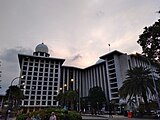 |
120,000 | 1975 | Central Jakarta, Jakarta | National mosque and largest mosque in Indonesia | |
| Palembang Grand Mosque |  |
1748, renovated in 1821 and 2003 | Palembang, South Sumatra | Largest mosque in South Sumatra.[citation needed] | ||
| Sabilal Muhtadin Mosque | 1979 | Banjarmasin, South Kalimantan | Largest mosque in South Kalimantan.[citation needed] | |||
| Bengkulu Grand Mosque | 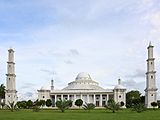 |
1988 | Bengkulu, Bengkulu | The main mosque of Bengkulu | ||
| Grand Mosque of Makassar |  |
1949, 1999 (renovated) | Makassar, South Sulawesi | The main mosque of South Sulawesi. | ||
| Bandung Grand Mosque |  |
23.448 m², building: 8.575 m² | 1812, 2003 (renovated) | Bandung, West Java | Originally built in Sundanese-Javanese style in 1812, renovated to present condition in 2001-2003 | |
| Great Mosque of Central Java | 15,000 | building 7,669 m² | 2006 | Semarang, Central Java | Largest mosque in Central Java |
By provinces
Template:Asian mosques There are 239,497 registered mosques in Indonesia (2012).[5] To be included in this list, the mosque has to be a landmark of particular region, and most importantly, historically notable or contains authentic vernacular architecture.
Mosques in bold have been listed in the table above.
Aceh
- Baiturrahman Grand Mosque, Banda Aceh
- Great Mosque of Meulaboh, West Aceh Regency
- Baiturrahim Ulee Lheue Mosque, Banda Aceh
- Great Mosque of Singkil, Aceh Singkil Regency
-
Ancient mosque of Indrapuri built above a Hindu candi in 17th century.
-
A mosque in Samalanga still showing the traditional Javanese multi-tiered roofs.
-
The Great Mosque of Meulaboh, finished in 1999. The mosque survives the Boxing Day Tsunami.
North Sumatra
Riau
West Sumatra
Traditionally, the architectural style of mosques in West Sumatra are characterized with three- or five-tiered roofs with the characteristic Minangkabau 'horned' roof profile. The roof is supported on ranks of concentric columns, often focusing on a towering central support which reaches the apex of the building. Some mosques are built on islands in artificial ponds. Traditional Minangkabau woodcarvings may be implemented in the facade.[2]
- Ganting Grand Mosque, Padang
- Muhammadan Mosque, Padang
- Grand Mosque of West Sumatra, Padang
- Nurul Iman Mosque, Padang
- Andalas Grand Mosque, Padang
- Nanggalo Grand Mosque, Padang
- Teluk Bayur Grand Mosque, Padang
- Rao Rao Mosque, Tanah Datar Regency
- Jami Mosque of Sungai Jambu, Tanah Datar Regency
- Jami Mosque of Taluak, Agam Regency
- Bingkudu Mosque, Agam Regency
- Grand Mosque of Bayur, Agam Regency (1999)
- Bawan Tua Mosque, Agam Regency
- Tuo Kayu Mosque, Solok Regency (16th century). Built in a vernacular Minangkabau architecture, possibly one of the oldest mosque in Indonesia.
- Grand Mosque of Koto Baru, South Solok Regency
- Tuo Koto Nan Ampek Mosque, Payakumbuh
- Nurul Islam Great Mosque, Sawahlunto
- Nurul Huda Mosque, Sawahlunto
- Grand Mosque of Sheik Burhanuddin, Padang Pariaman Regency
- id:Masjid Raya Balai Gadang Mungo, Limapuluh Koto Regency
- Mutaqaddimin Mosque, Limapuluh Koto Regency
- Great Mosque of Natuna, Natuna Regency
-
Typical Minangkabau mosque in a West Sumatran village.
-
Jami Mosque of Taluak in Agam Regency of West Sumatra.
Riau Islands
Jambi
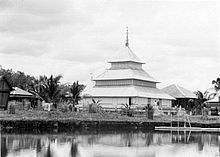

Bengkulu
South Sumatra
- Great Mosque of Palembang, Palembang
- Cheng Ho Mosque, Palembang
Bangka–Belitung Islands
Lampung
-
Masjid di Takengon (1910-1930)
Banten
West Java
- Main Mosque of University of Indonesia, Depok (1987).
- Grand Mosque of Bandung, Bandung
- Sang Cipta Rasa Great Mosque, Cirebon, part of the Kraton Kasepuhan (1480)
- At Taqwa Mosque, Cirebon (1951)
-
A mosque in Cirebon in the 1920s.
-
Great mosque of Garut in the 1920s
-
A modern mosque in University of Indonesia follows the language of the traditional multi-tiered roofs.
Jakarta
- Cut Mutiah Mosque
- Holy Mosque of Kampung Bandan
- Istiqlal Mosque (1975). The largest mosque in Indonesia.
- Sunda Kelapa Mosque
Central Java
- Al-Ittihad Mosque Jatibarang, Jatibarang (2008). Largest mosque in Brebes.
- Menara Kudus Mosque, Kudus
- Great Mosque of Demak, Demak (15th century)
- Great Mosque of Central Java, Semarang (2006)
- Great Mosque of Surakarta, Surakarta (1768)
-
A mosque in Pati, taken in early 20th century.
-
The minaret of the Kudus Mosque.
Yogyakarta
East Java
- Al Akbar Mosque, Surabaya
- Ampel Mosque, Surabaya
- Great Mosque of Malang, Malang
- Miftahul Jannah Mosque, Takerharjo, Solokuro, Lamongan
- Great Mosque of Sumenep, Sumenep
-
A 20th century photograph of a mosque in Surabaya]]
Bali
West Nusa Tenggara

- Bayan Beleq Mosque, Bayan, Lombok Utara
West Kalimantan
- Babul Chair Mosque, Ketapang Regency
- Jami Mosque of Landak, Landak Regency
- Jami Mosque of Sambas, Sambas
- Jami Mosque of Pontianak, Pontianak
- Jami Mosque of Sungai Nata, Sintang Regency
- Nurul Huda Mosque of Sungai Jawi, Ketapang Regency
Central Kalimantan
South Kalimantan

- Holy Mosque of Banua Halat, Tapin Regency
- Al-Karomah Great Mosque, Martapura
- Ba'angkat Mosque, Simpur
- Jami Mosque of Banjarmasin, Banjarmasin
- Jami Mosque of Sungai Banar, Amuntai, Hulu Sungai Utara Regency
- id:Masjid Jami Tuhfaturroghibin, Alalak, Banjarmasin
- Kelayan Muhammadiyah Mosque, Banjarmasin
- id:Masjid Pusaka Tabalong, Banua Lawas
- Grand Mosque of Sabilal Muhtadin, Banjarmasin
East Kalimantan

- Aji Amir Hasanuddin Jami Mosque, Tenggarong, Kabupaten Kutai Kartanegara
- Imanuddin Grand Mosque, Kabupaten Berau
- Darussalam Grand Mosque, Samarinda
- Mosque of Islamic Center Samarinda, Samarinda (2008)
- Shiratal Mustaqiem Mosque, Samarinda
- Sultan Suriansyah Mosque
South Sulawesi
-
Masjid Gowa (1920s)
Maluku
- Wapauwe Mosque, Ambon (1614)[citation needed]
North Maluku
Papua
- Masjid Agung Babussalam, Timika
References
- ^ Gunawan Tjahjono. Indonesian Heritage-Architecture. Singapore: Archipelago Press. pp. 86–87.
- ^ a b c d e Gunawan Tjahjono. Indonesian Heritage-Architecture. Singapore: Archipelago Press. pp. 96–97.
- ^ Iskandar Zulkarnaen (2003). Sejarah Sumenep (in Indonesian). Sumenep: Dinas Pariwisata dan kebudayaan kabupaten Sumenep.
- ^ Watson, C. W. (1992). [lucy.ukc.ac.uk/csacpub/watson/chap1.html Property and Inheritance in Kerinci, Central Sumatra]. Canterbury: CSAC Monographs. ISBN 0 904938 19 0. Retrieved January 1, 2013.
{{cite book}}: Check|url=value (help) - ^ Fenny Melisa (June 3, 2012). "Pertumbuhan Masjid di Indonesia Rendah". Republika. Retrieved December 31, 2012.


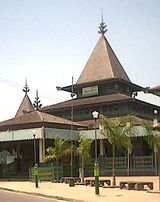







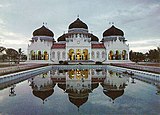













![A 20th century photograph of a mosque in Surabaya]]](http://upload.wikimedia.org/wikipedia/commons/thumb/6/63/COLLECTIE_TROPENMUSEUM_Moskee_Surabaya_Java_TMnr_10016739.jpg/120px-COLLECTIE_TROPENMUSEUM_Moskee_Surabaya_Java_TMnr_10016739.jpg)
